The Back Room Books (Comic)
Banned books and their stories.
Updated: Sept 25, 2025
Authors: Emily Morrow
This project is an individual assignment focusing on the implementation of design tools and multimedia principles in formatting an effective and educational comic. My goals with this project are to create a comic that is engaging and to gain a deeper understanding of multimedia learning.
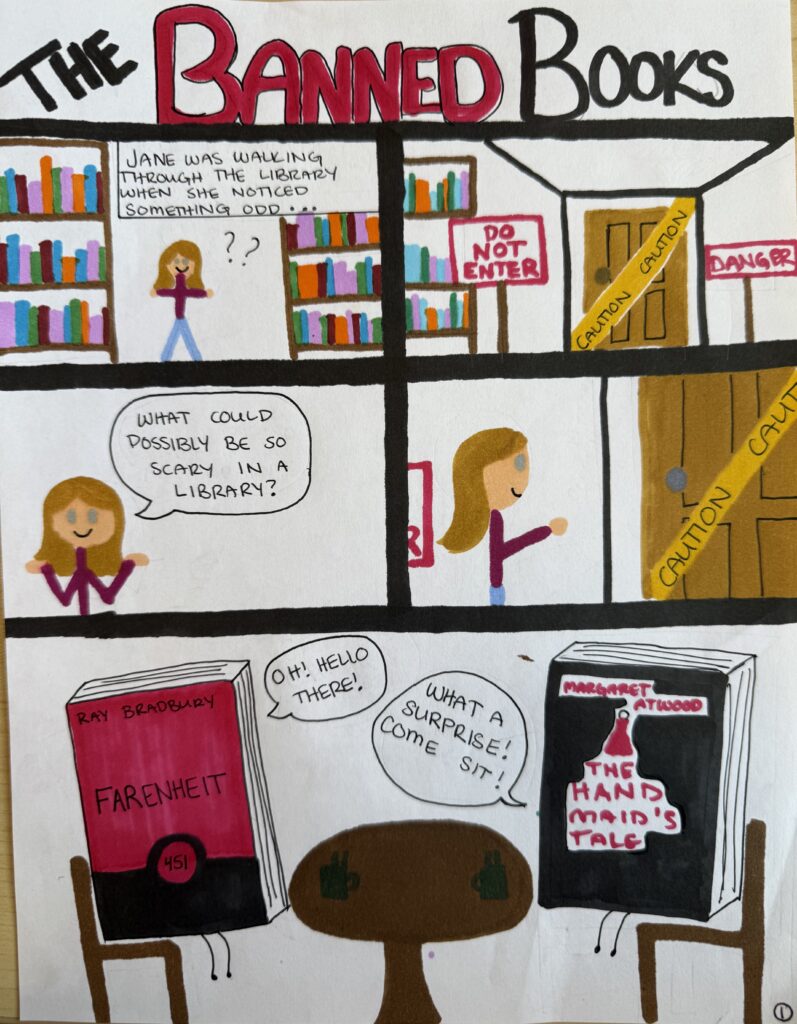
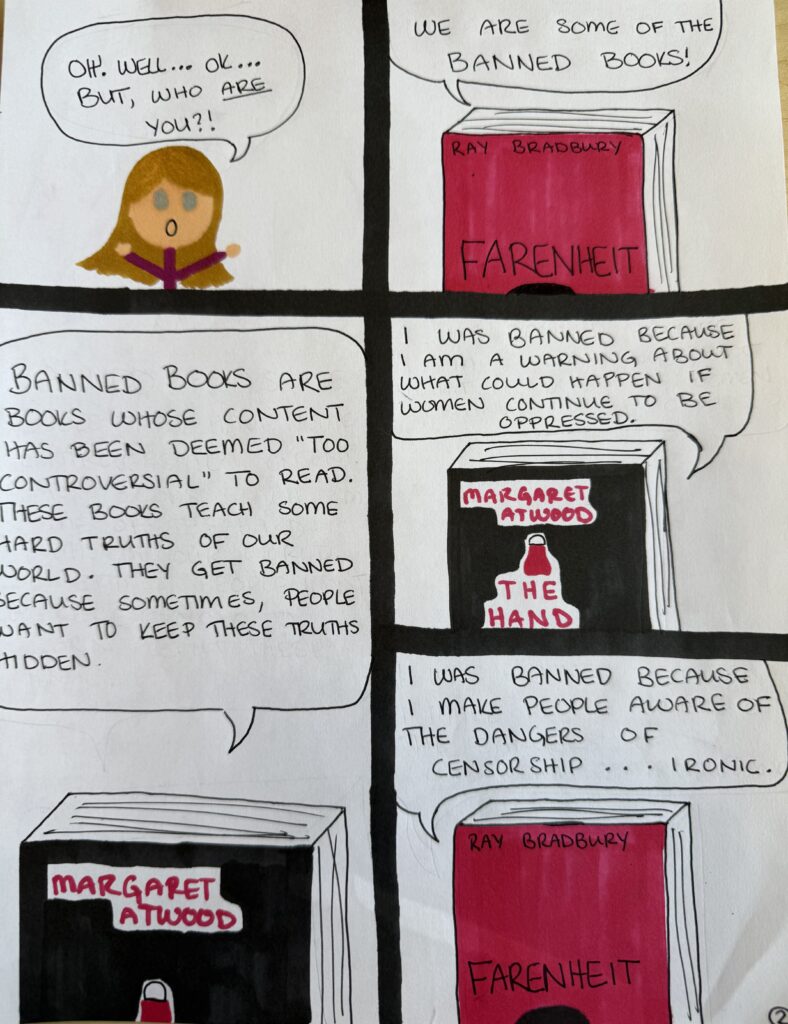
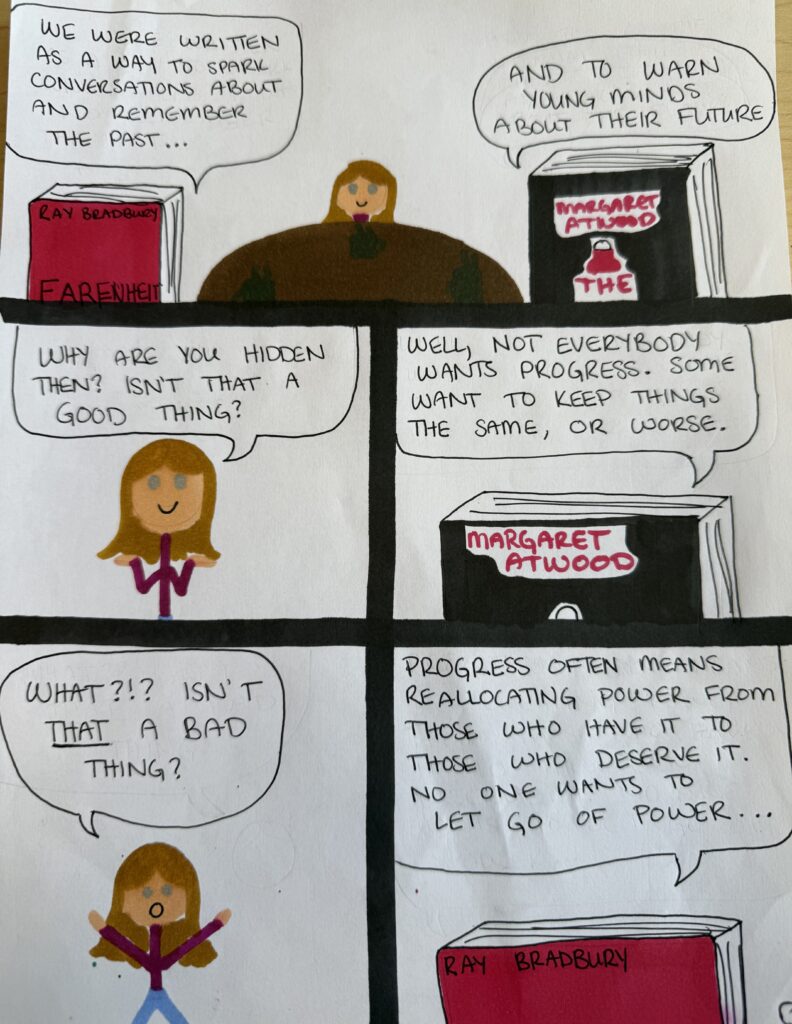
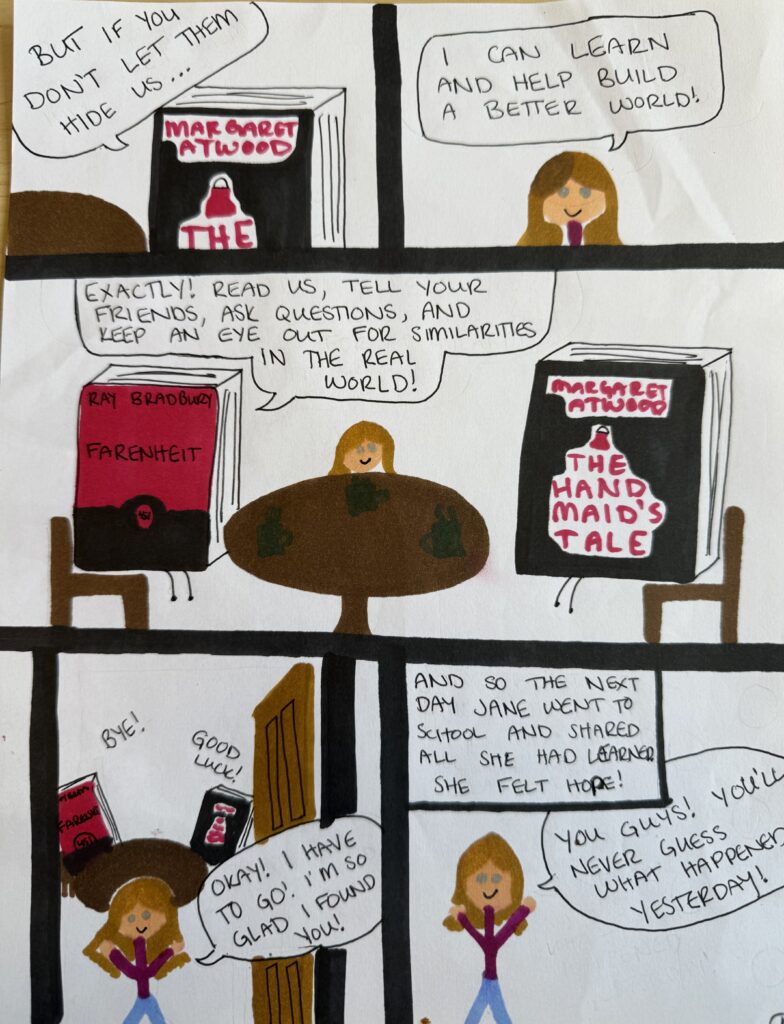
THE PROCESS
Understand (Discover, Interpret, Specify)
DESCRIBE THE CHALLENGE:
It is imperative that as more books become banned from schools, we continue to engage with the literature and look at the social and political implications of this.
CONTEXT AND AUDIENCE:
This comic is created mainly for secondary school students. The reason I have selected this demographic is because book banning has become increasingly relevant in high schools across the US and now Canada. As we see provinces beginning to ban certain books, we must start making youth aware of this and why it is happening. I chose to not make the comic for elementary or middle school aged children as I feel the content is slightly more mature despite the light hearted nature of the graphics.
While this is an important demographic to educate, teenagers are notoriously hard to impress or intrigue. Especially with the growth of social media and decline of literature consumption, this group may beg the question “why do I care?”. To intrigue the target demographic, something easily consumable, exciting to look at, and slightly light hearted seems like it will be the most effective way to engage them in material they might not engage with otherwise.
Extending the demographic, post secondary students and adults may also benefit from this style of learning. While some may be acutely aware of the dangers and frequency of book banning, not all understand that it is happening or what it is. It is key for everyone to be aware of book banning and why it happens. The goal of this comic is to expose some of the pieces of literature that have been banned, why they have been banned, and encourage the reader to critically assess if they agree with this decision or not. With constant debate and tensions about limits on free speech, it is important to challenge learners to think about the consequences of removal and censorship.
POV STATEMENT:
Students need to be aware of the books that have been banned so that they can educate themselves on the content and assess the implications of the ban.
LEARNING OBJECTIVES:
Readers will understand the concept of banned books and be able to assess the implications of which books have been banned and the power used to ban them. This hopefully will inspire the reader(s) to share with others about this topic.
Plan (Ideate, Sketch, Elaborate)
IDEATION:
- My brainstorming process started by looking at ideas that would be taught in a secondary school English classroom such as punctuation placement and sentence structure but these didn’t really intrigue me. I thought about being in an English class and the discussions that arise about themes in novels: morality, loyalty, heartbreak, political turmoil, etc. Turning those concepts into a comic intrigued me and could help students create mental models of themes. I couldn’t think of a way to turn a novel’s theme into a comic without having to over complicate this assignment with the context of the novel. I remembered a news post I saw a few weeks ago about books being banned in Alberta classrooms. I always found this such an intriguing topic and remembered that in high school I was completely unaware that this was something that could even happen. I liked the idea of painting the books as these scary monsters from afar but when you get up close you realize they are harmless and just trying to help. I figured the best way to do this was to have them be depicted to an outsider as monsters locked in a back room. When a student stumbles upon them, full of fear, we realize they are harmless. I like the concept of letting the books speak for themselves as well.
- The best ideas I have come up with have included fun graphics and colourful designs. As well as dialogue between the main character and the books.
STORYBOARD OR SCRIPT:
| Kid walking through library – happy | Shot of a sign “WARNING: go no further” | Kid confused – goes further “what could be so scary in a library?” | More signs and caution tape – kid starts shaking – bead of sweat on forehead |
| A creepy looking door – hears sounds from behind it | Nervously goes up and grabs handle | Door slowly creaks open | Kid peaks in |
| Larger than normal books sitting quietly (Farenheit 451, To Kill a Mockingbird, The handmaids tale) turn to ‘look’ at kid | They are excited to see the kid and invited it to join at table for conversation | Kid asks “who are you?” | Books: “we are what they don’t want you to know” |
| Kid confused “who doesn’t want me to know? Know what” | Book 1 says its title and why it is banned | Book 2 says its title and why its is banned | Book 3 says its title and why it is banned |
| Book 1 ‘ we were written as a way to remember the past and see the future’ | Kid “isn’t that a good thing?” | Book 2 ‘some people don’t think so’ | Kid “ why would they hide you? Why is it bad?” |
| Book 3 “the people who made us scare the people who banned us” | Book 2 “we’re supposed to help stop the past from repeating itself” | Book 1 “But some people want that. So they don’t want you to read about what happens when they slowly start repeating it” | Kid “That sounds scary! Some things that are in your stories are really hurtful to people. How can we stop those people from doing it again if you guys are hidden” |
| Book 1 “Don’t let them hide us! There are more like us too. Read us all and share with people you know” | Book 2 “Ask questions to the people around you. Look out for people who remind you of the villains in these books” | Book 3 “If you and your friends choose to remember us, then we will be able to help guide you” | Kid “I gotta go! Thank you guys, I’ll keep you in my mind forever! And I’ll take down those scary signs that lead to you” |
PRINCIPLES APPLIED:
- Limited Capacity Principle: Choosing books that are likely to be familiar to the reader helps lift any extraneous load. Making the dialogue fairly simple aims for a low intrinsic load for most people in the target demographic. This creates optimal germane load allowing readers to fully understand the content and make their own connections.
- Signalling principle: Having the danger signs and a creepy feel to the room the books are in highlights the importance of them to the story and also creates the emotion you are supposed to feel toward them.
- Contiguity principle: The speech bubbles or narrations will be held within the same box as the picture they are referring to to ensure the most ease in interpretation.
- Personalization principle/voice principle: Having the books be animated and talking helps to create a unique experience and make the content more approachable than if it were to just be written out.
- Modality: Having the words alongside the pictures will be more impactful than the words on their own.
Create and Share the Prototype
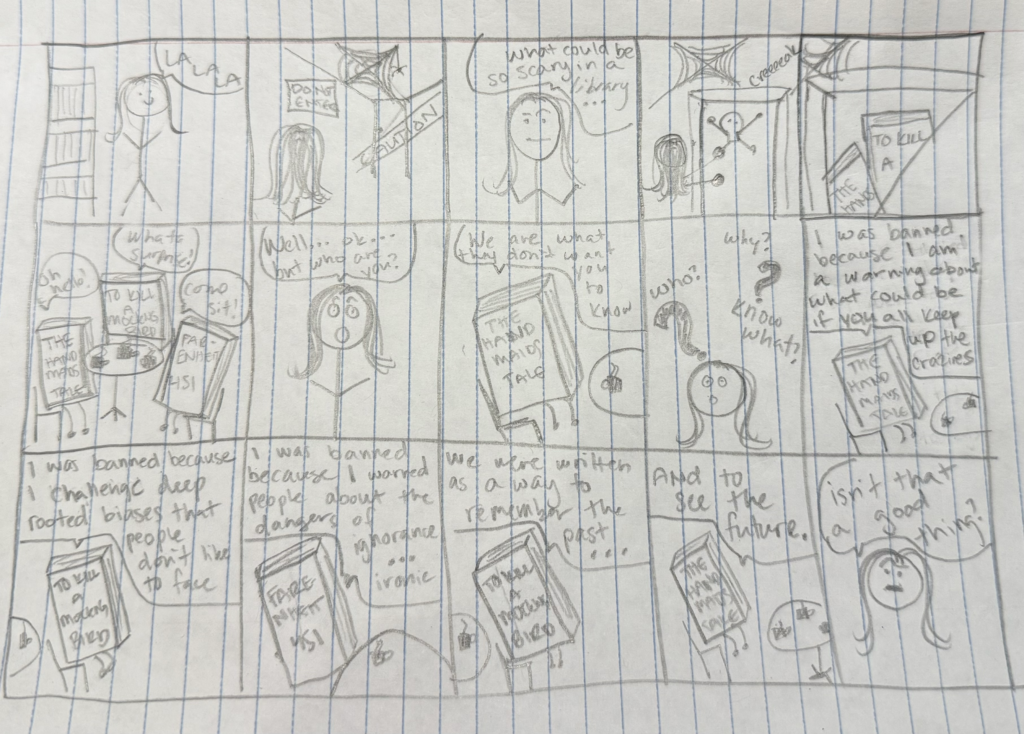
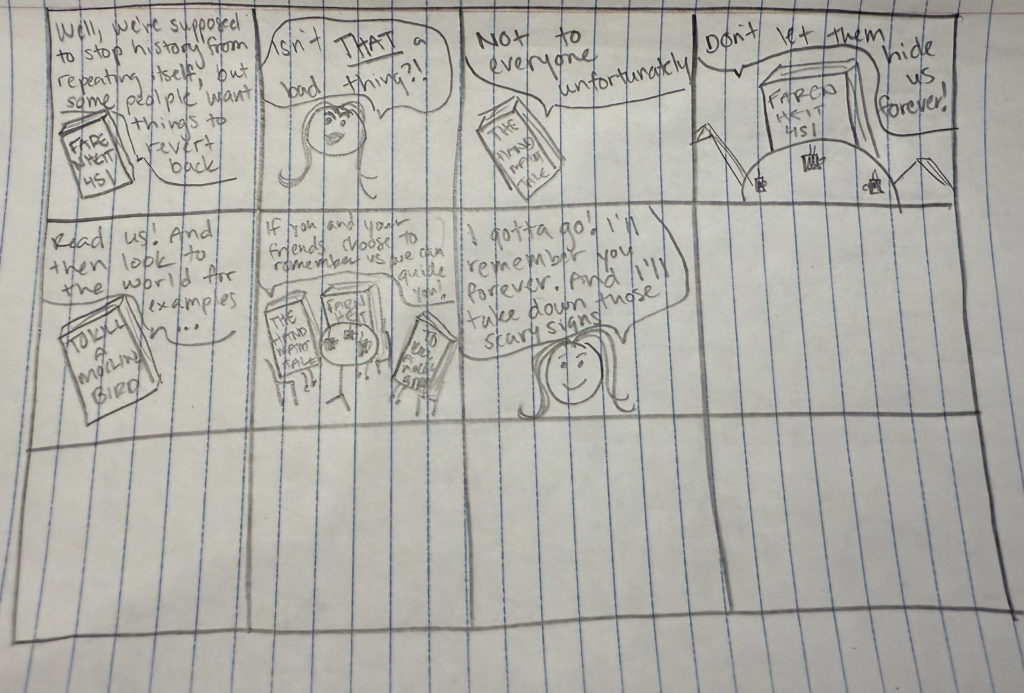
PEER FEEDBACK:
The positive feedback for my comic mostly referenced the topic and my decisions about how to address it. It was said that I chose an intriguing and important topic and successfully made it lighthearted. Also that the format of ‘allowing the books to speak for themselves’ was powerful in the context of banned literature. It was also mentioned that the mysterious setting was a good and engaging choice for this topic.
The constructive aspect of the feedback was very useful in refining my project. One note was that having three books as part of the comic was too much and caused some confusion and limited processing capacity. Since the topic is complex, it was suggested to keep the rest of the elements more simple. Another piece of feedback was to include a panel that specifically explains what a banned book is. I did not have this before and the reviewers felt that hindered their ability to engage with the message. Finally from a visual aspect, it was suggested to make the story elements visually dynamic as opposed to pencil because it made the books look too similar and didn’t allow for key parts to stand out.
Reflect and Refine
REFLECTION:
The comic format was effective in the coverage of a complex topic in a lighthearted and easily consumable way. I liked having the ability to turn education into a narrative with a more informal presentation that creates an accessible feel for students. I think the strongest aspect of a comic is the ability to utilise the dual coding theory in a creative way as opposed to the typical lecture with slides format. Having the visual and verbal pathways active at the same time increases memory retrieval therefore increasing the benefits of consuming educational content in this way (Loveless, 2023). In the comic I also chose to use minimal colours and objects which makes dual coding even more efficient, but is also helpful for reducing the extraneous load on the reader (Loveless, 2023).
Extraneous load is when information draws on cognitive resources without contributing to learning (Granchelli, 2025). An issue I faced in my prototype was an overwhelm of information and overcrowding of characters which made the extraneous load on readers quite high. Feedback I received suggested I remove one of the original three novels to reduce distracting and unnecessary material. This allows readers to become familiar with the content quicker because there is less to consume. Once I made this change, my final draft was much more concise, enjoyable, and efficient.
Another reason comics are a useful education tool is because they have inherent temporal contiguity. This is when learning efficiency is increased because of the presentation of an image and its description at the same time (David, 2016). An inherent part of comic structure is including corresponding images and text in the same panel. I learned through trial and error that a way to extend the benefits of this is to include as few figures and text bubbles in a panel as possible. One character and one text bubble is ideal if you are imparting a fair amount of information. That being said, I also found that at times it is impactful to have multiple characters in the same panel to support the storyline. To minimize overwhelm in this situation, I expanded the size of the comic panel and reduced the amount of dialogue happening in these panels.
Something I found limiting with the comic was the inability to include a lot of information. While you can include a good amount of information about a specific topic, often topics are more complex and would benefit from more contextual information or sub topics to inform the main point. I had to reduce some of the information I had originally included to maximize germane load (Granchelli, 2025). A way this could be avoided in a classroom setting could be to create a comic series. Each comic details a different aspect of or piece of context for the overarching topic. This would increase the students prior knowledge therefore allowing for less cognitive load and more germane load.
Overall, I think the comic is a strong tool for learning as long as it is utilised properly. This means considering all design principles to maximize efficiency and minimize complication. Comics are a refreshing type of media to bring into the classroom as they are easily consumable and the graphics make them more interesting than a typical paper
David Hendricks Professional Work. (2016, April 17). Cognitive load theory, how do I apply it? [Video]. YouTube. https://www.youtube.com/watch?v=stJ-MkTgRFs
Granchelli, Adrian. (2025). Theories of multimedia learning EDCI 337. Educational technology Uvic. https://edtechuvic.ca/edci337/2025/09/05/theories-of-multimedia-learning/
Loveless, Becton. (2023, April 14). Dual coding theory: The complete guide for teachers. Education Corner. https://www.educationcorner.com/dual-coding-theory/